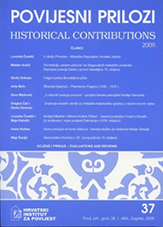Od tradicije „sedam pobuna“ do dragovoljnih mletačkih podanika Razvojna putanja Zadra u prvome desetljeću 15. stoljeća
From the tradition of the ‘seven rebellions’ to the voluntary Venetian subjects: the development of Zadar in the first decade of the fifteenth century
Author(s): Mladen AnčićSubject(s): History
Published by: Hrvatski institut za povijest
Keywords: local elites; state organization; Kingdom of Croatia-Hungary; Venice; Zadar
Summary/Abstract: The author starts from the perceived discrepancy between the historiographic view of the circumstances in which Venice took the possession of Zadar in 1409 and the information obtained from archival sources, to examine the real events and to place them within the framework of a discussion of the relationship between the medieval state authority and the local power elites. In the first part of the essay, the author discusses the appearance of a group of five noblemen who in the course of the summer of 1401 succeeded in taking control of the political life of Zadar. The group included three noblemen whose conflict with the king of Croatia-Hungary, Sigismund, had forced them to leave the town. They returned to Zadar only after the rebellious Hungarian nobility had captured and imprisoned the King in the April of 1401. The author then analyzes the ways in which the remaining members of the group, two noblemen who had spent these four years in the town, could have been connected to the refugees. Looking at the circumstances in which the group of five took control of the political life of Zadar, the author concludes that the key to their success was probably the leading role they played in the repossession of the island of Pag, the centre of salt production and the foundation of the Zadar power, which had been taken from the town by the King in 1396. In the second part of the essay, the author uses the extant literature and reinterprets the printed and archival sources to redefine the successive waves of rebellion against the king Sigismund. In the third part of the essay, the author, availing himself of barely used sources, discusses the mechanisms that Ladislas of Naples and his main adherent on the East Adriatic Coast, the new Herceg of Split, used to tie the political leaders of Zadar to themselves. In the concluding discussion, the author shows that it was precisely the fact that both the territorial expansion of the town and the accumulation of wealth in the hands of those who controlled the town were based on the gifts of the Sigismund’s supporters’ estates, significantly reduced the possible scenarios of resolving the political crisis.
Journal: Povijesni prilozi
- Issue Year: 2009
- Issue No: 37
- Page Range: 43-96
- Page Count: 53
- Language: Croatian

